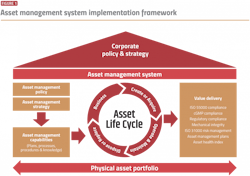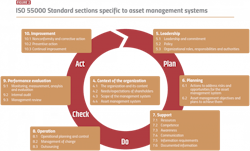The Industry 4.0 term has been around since 2011 — and one could argue that the concepts were in place well before it earned the name.
The International Society for Pharmaceutical Engineering’s (ISPE) Pharma 4.0 Special Interest Group (SIG) has been working since 2015 to translate how Industry 4.0 impacts pharmaceutical regulations and pharma manufacturing’s unique requirements. ISPE believes moving to Pharma 4.0 represents a competitive advantage to the extent that not embracing its potential might be a business risk.
In Industry 4.0/smart factory transformations there are many choices in terms of technologies and how to deploy them. These include Industrial IoT, cloud and edge computing, robotic process automation (RPA), artificial intelligence (AI), machine learning and augmented and virtual reality (AR/VR) systems. These technologies have at least one thing in common: They claim they can deliver benefits like reduced cost and downtime, and improved throughput, quality and safety. And of course, these promised benefits would translate to better bottom-line profit.
Yet while there are companies today that have deployed significant levels of digital technology, there are very few that have effectively leveraged it. With all of the potential benefits of 4.0, why have so few companies deployed a 4.0 strategy? For those companies on the 4.0 journey, where is the return on investment?
According to the SIG operating model, data integrity, organization and processes, and culture form the “foundation.” This makes sense because preparing your organization and people to reap the benefits of Pharma 4.0 goes well beyond just understanding new technology. It requires a comprehensive asset management strategy, based on detailed mapping of all of the stakeholders, which encompasses people and processes and ensures that new technology solutions align with the organization’s objectives and stakeholder requirements.
Aligning with asset management strategies
Due to the high level of regulatory scrutiny, the typical pharma company has a fairly good handle on its physical assets. They know what assets they have and understand the validated operating parameters. They have typically done a high level of asset criticality analysis based on the level of direct contact that asset has with the product. They have specific standard operating procedures (SOPs) that govern how the product is to be produced and a robust quality management system (QMS) that monitors compliance and approves corrective and preventive actions (CAPA) activities from deviation investigations.
Yet many organizations are unsuccessful in deploying effective 4.0 strategies because they lack the ability and insight to right-size their specific digital transformation and align it to a comprehensive asset management strategy. These organizations often do not have sufficient foundational asset management competencies to take advantage of technologies that (theoretically) will improve organizational performance. To gain a positive ROI on 4.0 initiatives, firms need to master fundamentals in order to realize the potential benefits of cutting-edge technical tools.
The ISO 55000 series — the international standard for asset management — can guide alignment to your organization’s unique mission and stakeholder requirements with decision-making about which elements of automation and digital transformation are appropriate, and how to prepare for them.
The standard spells out how to create an asset management system that provides a structured approach for the development, coordination and control of asset-related activities across their life cycle. It emphasizes understanding and managing the value and risk to internal and external stakeholders.
An asset management system (Figure 1) defines how assets will be managed across their life cycle to meet what ISO calls stakeholder requirements. As explained in the ISO 55001 standard, these activities are documented in the asset management policy, strategy, objectives and plans. The purpose of these documents is to set the principles by which the organization intends to apply asset management to achieve its organizational objectives.
The power of an asset management system comes from the effectiveness of the asset management capabilities. These are the plans, processes, procedures and knowledge that, when applied effectively across all stages of the asset life cycle, will provide the optimal return on the investment.
The ISO Asset Management Policy and Strategic Asset Management Plan (SAMP) documents the high-level expectation that the organization’s stakeholders have for the performance of the assets. This process considers all internal and external stakeholders. Completing the stakeholder analysis builds a clear understanding of the criticality of the assets as it relates to impact to the value stream.
Very few organizations have the resources to evaluate every potential failure of every asset, so you must focus resources on the most critical assets. You can use a variety of methods and tools, from simple system failure modes and effects analysis (FMEA) to more detailed computer modeling. From this analysis, you can identify the most likely failure modes, develop the optimal mitigation strategies and create the metrics that verify the system is working as designed. You can determine what sensors and data you have or need to install, to allow your system to proactively monitor, predict and intercede to mitigate failures before they cause loss of product.
As your organization’s 4.0 systems mature you can leverage technologies to make adjustments and/or notify the right people at the right time to make those adjustments. As the accuracy of the information improves you can feed it back into the engineering and design process to build more robust assets on future projects.
Preparing people for the 4.0 environment
Just as you identify where the issues are in designing, operating, and maintaining your assets, you also need to identify whether you have the people and organizational competencies needed to operate in the 4.0 environment. Both ICH Q10 (the Pharmaceutical Quality System) and ISO 55001 speak to the management requirement of providing qualified competent resources. Figure 2 represents the sections of the ISO 55001 standard specific to asset management systems.
The “support” section speaks to having the necessary resources in place to accomplish those asset management objectives. This is the connection to identifying not just the processes to be followed and the technologies to be used, but also the competency of the people who will do the work. The standard specifies that the organization has a process for identifying competency requirements for asset management and assessing the competence of resources, both internal and external.
Most organizations have a solid understanding of where the current gaps in performance are, based on personal performance evaluation systems. To make sure your organization will have the right people with the right competencies in place for a digital future you will need to analyze how work will be done differently and adjust roles and responsibilities.
A good tool for determining if training will help an individual develop required competencies is the Learning Impact Map (LIM). Used correctly, a LIM facilitates management support and aligns expectations. This support and engagement are necessary to change behavior. The LIM creates a direct line of sight between individual behavior and organizational goals, aligning learning objectives with expected behavior changes.
A LIM is a table or document that:
- Facilitates management support and aligns expectations
- Identifies if training can achieve desired results in terms of broad business goals
- Prepares participants to learn and change behavior based on training
- Links the desired behavior with organizational performance and business goals
A well-written LIM always shows the skills the participant will learn in the training, behaviors driven by the new knowledge, and the results that will be realized by the new behaviors.
Is your company ready for change?
ICH Q10 and ISO 55001 also acknowledge the need for an organization to be capable of change — not just change to systems or policies, but also adapting to new ways of working. This is very relevant when considering the requirements for an organization to engage in digital transformation. To reap the benefits and ROI, an organization needs a structured approach for adapting to change. If your people aren’t ready to adopt new ways of working, the power of enabling technologies will be lost.
When it comes to implementing asset management best practices, implementing new technology is relatively easy. The hard part is changing the culture — getting people to adopt a new way of doing business when they may have done a job a certain way for 30 years. What’s required is Organizational Change Management (OCM). Prosci, the global leader in change management best practices research, describes OCM as “the application of a structured process and set of tools for leading the people side of change to achieve a desired outcome.”
Many manufacturing professionals are project managers who have worked on the technical side of change a lot. But the people side of change is what’s crucial for successful transformations. Simply stated, if the people don’t change, there is no change. A company can develop new policies and procedures but if people don’t adjust the way they do their work, if they don’t adopt the new procedures and implement those changes, then no change really occurs. So the achievement of the organization really is the result of the combined effort of the people.
There is no cookie-cutter answer to Pharma 4.0, Industry 4.0, IIoT or digital transformation. But there are proven processes and methods that can be followed to prioritize the capabilities and competencies needed. This will provide near-term tactical benefits while developing long-term initiatives and principles that align with their organization’s strategic objectives. Organizations need to roll out a performance improvement strategy aligned to the stakeholder requirements and verify that their workforce has the knowledge and skills to adopt them. Once these foundational aspects are in place they can determine how using data will expedite, sustain, and continuously improve the business transformation goals and objectives.


